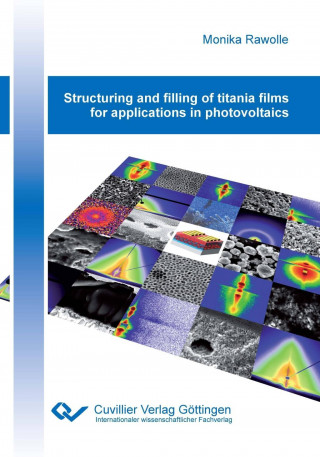
Kód: 12828408
Structuring and filling of titania films for applications in photovoltaics
Autor Monika Rawolle
Kurzbeschreibung Die Möglichkeiten, Titandioxid Nanostrukturen zu synthetisieren, sowie die erhaltenen Strukturen rückzubefüllen, werden mit Hinblick auf Anwendungen in der Photovoltaik in der vorliegenden Arbeit untersucht. Au ... celý popis
- Jazyk:
 Angličtina
Angličtina - Väzba: Brožovaná
- Počet strán: 334
Nakladateľ: Cuvillier Verlag, 2013
- Viac informácií o knihe

56.03 €
Bežne: 62.11 €
Ušetríte 6.08 €

Skladom u dodávateľa
Odosielame za 5 - 7 dní
Mohlo by sa vám tiež páčiť
-

Livin'la vida barroca : American culture in an age of imperial orthodoxies
22.22 € -

Muerte y juicio
21.09 € -1 % -

Cómo aprende el cerebro
10.85 € -4 % -

Glosas Castellanas y Otros Ensayos
18.64 € -

LECTURAS DE ECONOMIA POLITICA I
25.50 € -

Escritura 5 : método Pipe de lecto-escritura para alumnos con N.E.E.
12.39 € -4 % -

Devojka U Zapaljivoj Suknji
18.94 € -2 %
Darčekový poukaz: Radosť zaručená
- Darujte poukaz v ľubovoľnej hodnote, a my sa postaráme o zvyšok.
- Poukaz sa vzťahuje na všetky produkty v našej ponuke.
- Elektronický poukaz si vytlačíte z e-mailu a môžete ho ihneď darovať.
- Platnosť poukazu je 12 mesiacov od dátumu vystavenia.
Viac informácií o knihe Structuring and filling of titania films for applications in photovoltaics
Nákupom získate 138 bodov
 Anotácia knihy
Anotácia knihy
Kurzbeschreibung Die Möglichkeiten, Titandioxid Nanostrukturen zu synthetisieren, sowie die erhaltenen Strukturen rückzubefüllen, werden mit Hinblick auf Anwendungen in der Photovoltaik in der vorliegenden Arbeit untersucht. Auf Titandioxid basierende Solarzellen werden in Hybridsolarzellen und in Farbstoffsolarzellen unterteilt. Das Hauptaugenmerk der Untersuchungen liegt auf der Korrelation zwischen Morphologie und Funktion der resultierenden Strukturen. Die verschiedenen untersuchten Systeme und die damit verbundenen Fragestellungen umfassen zum einen die Strukturierung von Titandioxid und zum anderen das Rückbefüllen dieser Strukturen. Die Synthese von Titandioxid wird mittels Sol-Gel Chemie vorgenommen. Die Strukturen werden in der Synthese durch Blockcopolymertemplate vorgegeben. Die damit hergestellten dünnen Filme von Titandioxid zeigen eine hohe Porosität, mit einer Schwammartigen Morphologie die sowohl Mesoporen als auch Makroporen aufweist. Die Strukturen werden in dünnen Filmen und in einem nanostrukturierten Tropfen untersucht. Eine Verbesserung der Strukturen durch die Kombination der Sol-Gel Synthese mit Mikrofluidik wird ebenfalls diskutiert. Zudem wird eine mögliche Syntheseroute bei niedrigen Temperaturen vorgestellt, die es erlaubt kristallines Titandioxid zu erhalten. Die Stabilität der Strukturen gegen die Kapillarkräfte bei der Infiltrierung von Wasserdampf wird getestet. Um funktionierende Solarzellen zu erhalten, müssen die Titandioxidnanostrukturen mit einem lochleitenden Material gefüllt werden. Der Grad der Rückbefüllung mit lochleitenden Materialien korreliert mit der Funktion in Solarzellen. Description In the presented thesis, the possibilities to synthesize titania nanostructures and the possibilities to fill the resulting nanostructures by other materials are investigated for photovoltaic applications. The solar cells based on titania are distinguished either as hybrid or as dye-sensitized solar cells. The main focus of the investigations lies on the correlation of the morphology and the functionality of the obtained thin films. The different investigated systems and related questions comprise the structuring of titania on the one hand, and the filling of the structures on the other hand. Sol-gel chemistry in combination with block copolymers as structure templates is applied to obtain titania thin films with a sponge-like morphology, which shows a high porosity and both mesopores and macropores. The structures are investigated in thin films, but also in a nanostructured drop of titania. Improvement of the structures by the combination of micro-fluidics with the templated sol-gel is also discussed. Furthermore, a low temperature synthesis route is examined to obtain crystalline titania. The stability of the resulting titania films is checked for water vapor infiltration with the resulting capillary forces. In order to obtain working solar cells, the titania nanostructures need to be filled by hole-conducting materials. The degree of filling of the structures with hole-conducting organic materials is related to the functionality of the solar cells.
 Parametre knihy
Parametre knihy
56.03 €
- Celý názov: Structuring and filling of titania films for applications in photovoltaics
- Autor: Monika Rawolle
- Jazyk:
 Angličtina
Angličtina - Väzba: Brožovaná
- Počet strán: 334
- EAN: 9783954043842
- ISBN: 395404384X
- ID: 12828408
- Nakladateľ: Cuvillier Verlag
- Hmotnosť: 433 g
- Rozmery: 210 × 148 × 18 mm
- Dátum vydania: 02. April 2013
Obľúbené z iného súdka
-

Berserk Deluxe Volume 1
48.86 € -28 % -

Berserk Deluxe Volume 2
52.24 € -

Haunting Adeline
30.72 € -

Cry Baby Coloring Book
9.82 € -13 % -

Berserk Deluxe Volume 3
48.86 € -4 % -

The Official Stardew Valley Cookbook
23.76 € -18 % -

Hunting Adeline
31.75 € -

Atomic Habits
16.48 € -29 % -

Powerless
11.98 € -8 % -

Harry Potter and the Prisoner of Azkaban (Minalima Edition)
35.44 € -14 % -

House of Leaves
23.14 € -23 % -

Chainsaw Man, Vol. 15
10.44 € -20 % -

Berserk Deluxe Volume 4
46.50 € -9 % -

Gravity Falls Journal 3
18.33 € -14 % -

JUJUTSU KAISEN V22
10.75 € -18 % -

White Nights
3.58 € -

Dungeons & Dragons Essentials Kit (D&d Boxed Set)
30.42 € -

Iron Flame
16.28 € -25 % -

No Longer Human
13.51 € -17 % -

A Little Life
17.51 € -

Surrounded by Idiots
10.75 € -11 % -

Berserk Deluxe Volume 5
50.50 € -1 % -

Twisted Love
9.82 € -18 % -

Fourth Wing
10.23 € -15 % -

Twisted Lies
9.82 € -18 % -

Bungo Stray Dogs, Vol. 8 (light novel)
16.59 € -

Twisted Games
9.82 € -24 % -

Don't Believe Everything You Think
13.31 € -18 % -

BALLAD OF SWORD & WINE QIANG JIN JIU V01
16.59 € -22 % -

The 48 Laws of Power
24.58 € -10 % -

Berserk Deluxe Volume 6
51.11 € -

Court of Thorns and Roses Paperback Box Set (5 books)
50.91 € -28 % -

New Happy
17.41 € -39 % -

Court of Thorns and Roses
9.21 € -23 % -

The Creative Act
23.96 € -13 % -

Heaven Official's Blessing: Tian Guan Ci Fu (Novel) Vol. 1
18.02 € -16 % -

Reckless
11.87 € -18 % -

Court of Mist and Fury
9.41 € -19 % -

Icebreaker
9.21 € -23 % -

Dune Messiah
9.01 € -21 % -

Berserk Deluxe Volume 7
48.04 € -6 % -

Harry Potter and the Chamber of Secrets: MinaLima Edition
30.01 € -17 % -

Heaven Official's Blessing: Tian Guan Ci Fu Vol. 4
18.64 € -12 % -

Twisted Hate
10.13 € -16 % -

The Laws of Human Nature
16.07 € -5 % -

Vagabond (VIZBIG Edition), Vol. 2
26.32 € -8 % -

CHAINSAW MAN V14
11.26 € -

Heaven Official's Blessing: Tian Guan Ci Fu (Novel) Vol. 2
18.94 € -11 % -

Little Mushroom: Judgment Day
17.30 € -18 %
Osobný odber Bratislava a 2642 dalších
Copyright ©2008-24 najlacnejsie-knihy.sk Všetky práva vyhradenéSúkromieCookies


 21 miliónov titulov
21 miliónov titulov Vrátenie do mesiaca
Vrátenie do mesiaca 02/210 210 99 (8-15.30h)
02/210 210 99 (8-15.30h)